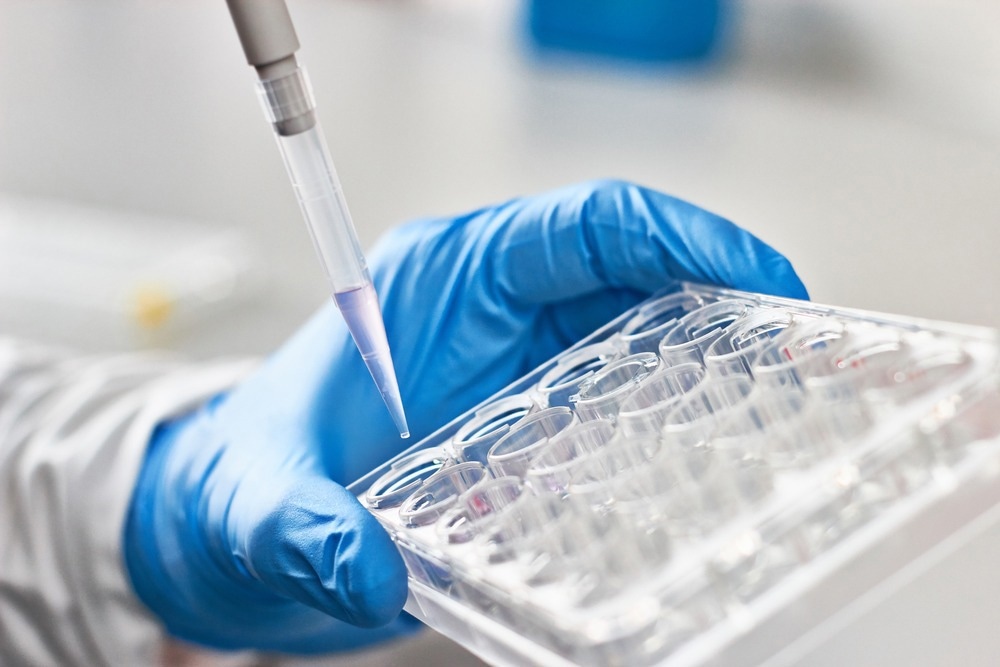Graphdiyne is a two-dimensional (2D) nanomaterial with excellent properties and a wide range of applications in electronic and optoelectronic devices. In an article published in the journal ACS Biomaterials Science and Engineering, graphdiyne was non-covalently grafted on a field-effect transistor (FET) device for biomarker anchoring and subsequent detection.

Study: Exploring the Role of 2D-Graphdiyne as a Charge Carrier Layer in Field-Effect Transistors for Non-Covalent Biological Immobilization against Human Diseases. Image Credit: Catalin Rusnac/Shutterstock.com
The immobilization of biological receptors on a graphdiyne-based FET device was possible through the charged graphdiyne layer that served as a bioaffinity substrate for the receptors. Pyrene groups on graphdiyne allowed the non-covalent anchoring of biological molecules via electrostatic interactions, facilitating an ultrasensitive detection mechanism in disease diagnosis.
The constructed graphdiyne-based FET device helped detect various biological molecules related to human disease. The results confirmed that the constructed graphdiyne-based FET device is a reliable strategy for label-free biosensing of receptors involved in diagnosing human disease.
The limit of detection (LOD) shown by the proposed device for DNA strands, SARS-CoV-2 (COVID-19) antigen, microRNA-155, CA19-9 antigen, and CA15-3 antigen were 0.2 attomoles, 0.003 femtograms per milliliter, 0.11 attomoles, 0.04 picounits per milliliter, and 0.043 picounits per milliliter, respectively.
Properties of 2D Materials
2D materials have gained ubiquitous applications in present technologies as researchers are able to tailor their features for specific applications. The excellent chemical, electrical, mechanical, and optical features of the 2D materials enhanced their applicability in various fields.
Graphdiyne is a 2D material with exceptional graphene features, containing sp2−sp hybrid structures, leading to a high percentage of π-conjunction. This conjugation facilitates finely ordered triangular holes and a highly resilient band gap in these materials. The ability of graphdiyne synthesis through cross-coupling promoted their implementation in energy conversion, gas separation, optoelectronic devices, and catalysis.
Gadgets with label-free detection mechanisms based on electrical and optical signals are desirable for sensing receptors involved in human disease. To this end, FET biosensors rely on electrical signals induced by the interactions between the sensitive surface of the device and biomolecules, which improves its applicability and versatility for new biosensor designs.
The surface of the 2D materials can be altered with desirable features via covalent and non-covalent functionalization methods. While the surface functionalization of 2D materials via covalent methods destroys their conjugate structure and eliminates the electrical characteristics, the non-covalent surface functionalization, including hydrogen bonding, electrostatic interactions, π−π interactions, and van der Waals forces, retain the electrical properties.
Role of Graphdiyne as a Charge Carrier Layer in FET Biosensors
Although various clinical and laboratory methods were previously established for detecting different biomarkers, the current strategy provided both simplicity and sensitivity in the detection process. Moreover, previous reports on a bioaffinity sensing application of graphdiyne were restricted to the electrochemical platform and fluorescence quenching. However, for the first time, graphdiyne's intrinsic property as a charge carrier was explored in the current work.
In the present study, graphdiyne-based FET devices were constructed based on the non-covalent grafting of graphdiyne. Here, the graphdiyne layer served as a charge carrier and bioaffinity substrate to immobilize biological receptors involved in human disease. Moreover, the surface functionalization of graphdiyne with 1-pyrene butyric acid (PBA), via π−π stacking, served as a linker between the FET device and biomolecule.
The pyrene group’s aromatic structure in graphdiyne interacted with the amine functional group in biological molecules, aiding in the biomolecule's anchoring to the surface of the graphdiyne layer. Thus, the probes (biological molecules) were anchored to the surface of graphdiyne via non-destructive, non-covalent interactions. While the non-covalent interactions helped retain the electrical properties in graphdiyne, the non-destructive interactions between probes and graphdiyne enhanced the robustness of the strategy.
Furthermore, five unique graphdiyne-based FET bioaffinity sensors were constructed to detect various biological target molecules (biomarkers), namely DNA strands, COVID-19 antigen, microRNA-155, CA19-9 antigen, and CA15-3 antigens. Subsequently, the alterations in charges were recorded based on the affinity interactions between the biomarkers and targets.
The results proved that the proposed graphdiyne-based FET devices demonstrated the flexibility of graphdiyne in designing FET biosensors and the high reliability of graphdiyne as a conductive layer for investigating other types of bio-/immunosensors that are devoid of risk of any destructive effect on biological molecules.
Conclusion
Overall, modified FET devices were constructed utilizing graphdiyne's charge transfer feature for biomarker detection in human disease management. Here, five graphdiyne-based FET biosensors were constructed to detect DNA, microRNA-155, CA19-9, CA15-3 tumor, and COVID-19 antigen, which served as biological analytes and related to the progress of various human diseases.
The graphdiyne platform was highly sensitive toward biological analytes in constructed FET devices, where the interactions between biological molecules and the graphdiyne surface led to charge alterations. Moreover, the fabricated graphdiyne-based FET biosensors demonstrated the versatility of graphdiyne in constructing FET biosensors and proved the robustness of graphdiyne to serve as a conductive layer for their integration into different bio-/immunosensors without causing any detrimental effects to the biological molecules.
The insignificant changes to the surface of designed biosensors reinforced the electrical signals, which was advantageous for their practical applicability. Moreover, the label-free biosensing ability of this biosensor can help detect the biomarkers in clinical samples.
Finally, the outstanding performance of the constructed label-free FET biosensors with low LODs, high sensitivity and selectivity, the capability of miniaturizing, and implantability for in vivo analysis makes their candidature promising in disease diagnostics and human health monitoring devices.
Reference
Ghafary, Z., Hallaj, R., and Ghasemi, F. (2022) Exploring the Role of 2d-Graphdiyne as Charge Carrier Layer in Field Effect Transistors for Non-Covalent Biological Immobilization Against Human Diseases. ACS Biomaterials Science and Engineering. https://pubs.acs.org/doi/10.1021/acsbiomaterials.2c00607









 Add Category
Add Category

